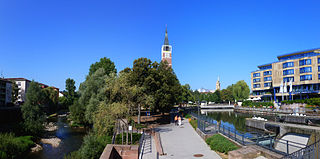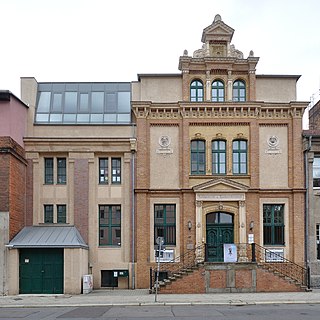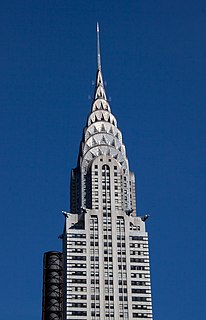
Costume jewelry, imitated jewelry; trinkets, fashion jewelry, junk jewelry, fake jewelry, or fallalery is jewelry manufactured as ornamentation to complement a particular fashionable costume or garment as opposed to "real" (fine) jewelry, which may be regarded primarily as collectibles, keepsakes, or investments.
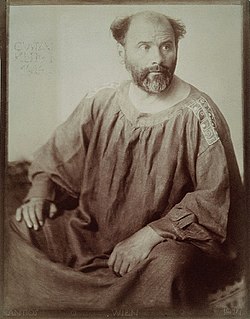
Gustav Klimt was an Austrian symbolist painter and one of the most prominent members of the Vienna Secession movement. Klimt is noted for his paintings, murals, sketches, and other objets d'art. Klimt's primary subject was the female body, and his works are marked by a frank eroticism. In addition to his figurative works, which include allegories and portraits, he painted landscapes. Among the artists of the Vienna Secession, Klimt was the most influenced by Japanese art and its methods.
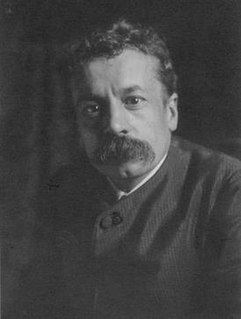
René Jules Lalique was a French glass designer known for his creations of glass art, perfume bottles, vases, jewellery, chandeliers, clocks and automobile hood ornaments.

Peter Carl Fabergé, also known as Karl Gustavovich Fabergé, was a Russian jeweller best known for the famous Fabergé eggs made in the style of genuine Easter eggs, but using precious metals and gemstones rather than more mundane materials. He was the founder of the famous jewelry legacy House of Fabergé.

Modern architecture, or modernist architecture was based upon new and innovative technologies of construction, particularly the use of glass, steel and reinforced concrete; the idea that form should follow function; an embrace of minimalism; and a rejection of ornament. It emerged in the first half of the 20th century and became dominant after World War II until the 1980s, when it was gradually replaced as the principal style for institutional and corporate buildings by postmodern architecture.

Interior design is the art and science of enhancing the interior of a building to achieve a healthier and more aesthetically pleasing environment for the people using the space. An interior designer is someone who plans, researches, coordinates, and manages such projects. Interior design is a multifaceted profession that includes conceptual development, space planning, site inspections, programming, research, communicating with the stakeholders of a project, construction management, and execution of the design.

Auburn was a brand name of American automobiles produced from 1900 through 1937.

Swarovski is an Austrian producer of lead glass headquartered in Wattens, Austria. The company is split into three major industry areas: the Swarovski Crystal Business, that primarily produces lead glass jewelry and accessories; Swarovski Optik, which produces optical instruments such as telescopes, telescopic sights for rifles, and binoculars; and Tyrolit, a manufacturer of grinding, sawing, drilling, and dressing tools, as well as a supplier of tools and machines.

Louis-Jean-Sylvestre Majorelle, usually known simply as Louis Majorelle, was a French decorator and furniture designer who manufactured his own designs, in the French tradition of the ébéniste. He was one of the outstanding designers of furniture in the Art Nouveau style, and after 1901 formally served as one of the vice-presidents of the École de Nancy.

Victor Mayer founded the jewellery manufacture Victor Mayer in Pforzheim in 1890. In the time of Jugendstil / Art Nouveau, the company created pieces based on the designs of well-known artists such as the jewellery designer Professor Georg Kleemann or Anton Krautheimer of the Munich Secession. In the art deco period and in the 1950s the manufacture focused mainly on fine gold and silver ware. From the 1970s onwards again more jewellery was manufactured. Until 1989 the company produced Fabergé jewelry for Fabergé & Cie in Paris. From 1989 until 2009, the company continued to produce Fabergé jewelry under license from Unilever New York until the brand license was sold. The manufacture Victor Mayer is well known for its high-end jewellery and the preservation of historical artisan techniques such as authentic fire enamel or guilloché.
A Fabergé workmaster is a craftsman who owned his own workshop and produced jewelry, silver or objets d'art for the House of Fabergé When Carl Fabergé took over the running of the business in 1882, its output increased so rapidly that the two Fabergé brothers could not manage all the workshops themselves. They therefore decided to establish independent workshops. The owners of these were committed to only work for the House of Fabergé that would supply the sketches and models of the objects to be made. Nothing would be accepted by the House unless it had been approved by either Carl or his appointed deputy. The House of Fabergé also employed its own designers. However we also know from the Memoirs of François Birbaum written in 1919 that Carl also designed himself.

Art jewelry is one of the names given to jewelry created by studio craftspeople. As the name suggests, art jewelry emphasizes creative expression and design, and is characterized by the use of a variety of materials, often commonplace or of low economic value. In this sense, it forms a counterbalance to the use of "precious materials" in conventional or fine jewelry, where the value of the object is tied to the value of the materials from which it is made. Art jewelry is related to studio craft in other media such as glass, wood, plastics and clay; it shares beliefs and values, education and training, circumstances of production, and networks of distribution and publicity with the wider field of studio craft. Art jewelry also has links to fine art and design.
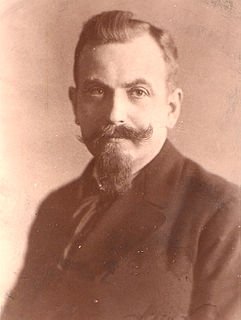
Evald Nielsen was a Danish silversmith and long-standing master of the Goldsmith's Guild of Copenhagen and one of the leading men behind the organizing of the Danish gold- and silversmiths.
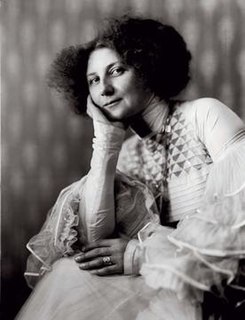
Emilie Louise Flöge was an Austrian fashion designer, and businesswoman. She was the life companion of the painter Gustav Klimt.

Paul Edmund Flato, was an American jeweler, based in New York City from the 1920s to the early 1940s. Considered the first celebrity jeweler, he was well known for important jewelry, and as an early proponent of whimsical pieces. His long list of movie star clients included Greta Garbo, Mae West, Rita Hayworth, Joan Crawford, Doris Duke, Ginger Rogers, Carmen Miranda, Marlene Dietrich, Katharine Hepburn, and Gloria Vanderbilt—many of whom wore his pieces on screen.
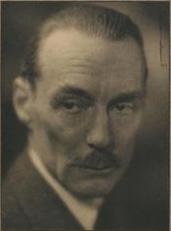
Maurice Dufrêne (1876–1955) was a French decorative artist who headed the Maîtrise workshop of the Galeries Lafayette department store.
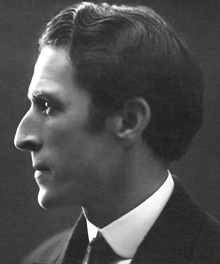
Paul Follot was a French designer of luxury furniture and decorative art objects before World War I (1914–18). He was one of the leaders of the Art Deco movement, and had huge influence in France and elsewhere. After the war he became head of the Pomone decorative art workshop of Le Bon Marché department store, making affordable but still elegant and high-quality work.

Fauxbergé is an ironic term coined to generally describe items that are faking a higher quality or status and in specific terms seem to relate to the House of Fabergé which is a jewellery firm founded in 1842 in St. Petersburg, Imperial Russia, by Gustav Fabergé. The term was first mentioned by auctioneer and Fabergé book author Dr. Geza von Habsburg in his article Fabergé in America. Today the term is a part of the expertise vocabulary in the vast and popular field of Fabergé products. It is even used in a recent museum show only about Fauxbergé items. The terms mainly refers to items that are exact copies or replicas of historical Fabergé products of the time period between 1842 and 1918. Fauxbergé jewelry started to show up on the market as soon as the Fabergé brand became a house hold name in the European aristocratic circles. After the second world war the trade of Fabergé products from communist Russia and other eastern block countries picked up and prices started to rise again. While an imperial easter egg auctioned in the 1930s for around 500 US Dollars it sold at auction for several million US Dollars after 1945. Direct copies and designs that look like Fabergé originals flooded the market. Fabergé did not entirely invent his own style but he himself copied historical pieces from European museum collections. It became a big business to erase marking stamps of historical or contemporary jewelry, silver and carved stones and place a false Fabergé stamp copy into the objects. Habsburg points out that an expert can see the difference between Carl Fabergé designed objects and fakes by simply looking at them. The production of Fabergé objects around 1900 poured out a much vaster amount of pieces than the popular perception. the reason for this being that imperial Fabergé Egges are actually limited to 54 pieces, while general Fabergé objects and jewelry items could exist in high numbers. It is estimated that the Fabergé company produced over a half a million products between 1842 and 1917. With over 500 craftsmen and designers in their employment, Carl Fabergé produced over 200,000 objects between 1882 and 1917. In its time Fabergé had been the most recognized and most highly valued jewelry brand in the world, surpassing Cartier and others by far. Today the big collections in Museums and private shows have Fauxbergé pieces in them and they in return are now considered curiosities. While the other famous jewelry brands are struggling to divide their market into originals and fakes the Fabergé non-brand of the second half of the 20th century enjoyed a collectors high of anything resembling Fabergé with the brand name attached to it or even without. In comparison, Fauxcartier objects do exist but these copies of the well known jeweler Cartier are not sought after or shown in exhibitions on purpose. Not all Fabergé items are protected by copyright law and especially collectors who own one of a kind creations are legally allowed to reproduce and sell such objects. Many museum stores offer replicas of their Fabergé objects form their collections. Carl Fabergé had may stores and shops and employed many freelance designers and jewelers. He had many so-called work masters who worked entirely independent from his business out of their own shops. These work masters kept producing their own objects with similar styles and these could have been stamped with false stamps in the succeeding years as well. Cartier and Tiffany's started to sell very similar frames and objects as Carl Fabergé and even bought from the same sources. Especially the stone sculptures which are never stamped or engraved can be mistaken for Fabergé originals. According to Habsburg a sure way to sort out fakes is that Carl Fabergé always used a maximum of two stamps and that most copies show more than two stamps.https://www.nytimes.com/1996/01/20/nyregion/about-new-york-imperial-gems-for-viewing-and-devouring.html Although Fauxbergé objects are frowned upon by experts they do enjoy a very high popularity and are often sold, collected and exhibited side by side with authentic Fabergé objects.https://www.washingtontimes.com/news/2011/aug/9/virginia-museum-fine-arts-displays-faberge-treasur/ The reason for the popularity of the replicas and false objects is that today they fall in the category of art rather than jewelry.
This article has been translated in part from the German Wikipedia.
